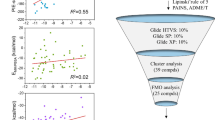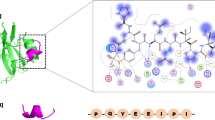Abstract
SHP2 phosphatase, encoded by the PTPN11 gene, is a non-receptor PTP, which plays an important role in growth factor, cytokine, integrin, hormone signaling pathways, and regulates cellular responses, such as proliferation, differentiation, adhesion migration and apoptosis. Many studies have reported that upregulation of SHP2 expression is closely related to human cancer, such as breast cancer, liver cancer and gastric cancer. Hence, SHP2 has become a promising target for cancer immunotherapy. In this paper, we reported the identification of compound 1 as SHP2 inhibitor. Fragment-based ligand design, De novo design, ADMET and Molecular docking were performed to explore potential selective SHP2 allosteric inhibitors based on SHP836. The results of docking studies indicated that the selected compounds had higher selective SHP2 inhibition than existing inhibitors. Compound 1 was found to have a novel selectivity against SHP2 with an in vitro enzyme activity IC50 value of 9.97 μM. Fluorescence titration experiment confirmed that compound 1 directly bound to SHP2. Furthermore, the results of binding free energies demonstrated that electrostatic energy was the primary factor in elucidating the mechanism of SHP2 inhibition. Dynamic cross correlation studies also supported the results of docking and molecular dynamics simulation. This series of analyses provided important structural features for designing new selective SHP2 inhibitors as potential drugs and promising candidates for pre-clinical pharmacological investigations.









Similar content being viewed by others
Abbreviations
- JMML:
-
Juvenile myelomonocytic leukemia
- MS:
-
Myelodysplastic syndrome
- AML:
-
Acute myeloid leukemia
- TCPTP:
-
T cell protein-tyrosine phosphatase
- PTP1B:
-
Protein tyrosine phosphatase 1B
- SHP1:
-
SH2 domain-containing phosphatase 1
- H bond:
-
Hydrogen bond
- ADMET:
-
Absorption, distribution, metabolism, excretion, and toxicity
- MCSS:
-
Multi-copy simultaneous search
- FBDD:
-
Fragment based drug design
- HIA:
-
Human intestinal absorption
- BBB:
-
Blood–brain barrier
- PPB:
-
Aqueous solubility plasma protein binding
- PME:
-
Particle mesh Ewald
- MM-PBSA:
-
Molecular mechanics Poisson Boltzmann surface area
- LCPO:
-
Linear combination of pairwise overlaps
- DCC:
-
Dynamic cross correlation
- MD:
-
Molecular dynamics
- HTVS:
-
High throughput virtual screening
- RMSD:
-
Root mean square deviation
- RMSF:
-
Root mean square fluctuation
References
Hof P, Pluskey S, Dhe-Paganon S, Eck MJ, Shoelson SE (1998) Crystal structure of the tyrosine phosphatase SHP-2. Cell 92(4):441–450
Chen C, Cao M, Zhu S, Wang C, Liang F, Yan L, Luo D (2015) Discovery of a novel inhibitor of the protein tyrosine phosphatase Shp2. Sci Rep 5:17626. https://doi.org/10.1038/srep17626
Zhang X, He Y, Liu S, Yu Z, Jiang ZX, Yang Z, Dong Y, Nabinger SC, Wu L, Gunawan AM, Wang L, Chan RJ, Zhang ZY (2010) Salicylic acid based small molecule inhibitor for the oncogenic Src homology-2 domain containing protein tyrosine phosphatase-2 (SHP2). J Med Chem 53(6):2482–2493. https://doi.org/10.1021/jm901645u
Yang W, Wang J, Moore DC, Liang H, Dooner M, Wu Q, Terek R, Chen Q, Ehrlich MG, Quesenberry PJ, Neel BG (2013) Ptpn11 deletion in a novel progenitor causes metachondromatosis by inducing hedgehog signalling. Nature 499(7459):491–495. https://doi.org/10.1038/nature12396
Lawrence HR, Pireddu R, Chen L, Luo Y, Sung SS, Szymanski AM, Yip ML, Guida WC, Sebti SM, Wu J, Lawrence NJ (2008) Inhibitors of Src homology-2 domain containing protein tyrosine phosphatase-2 (Shp2) based on oxindole scaffolds. J Med Chem 51(16):4948–4956. https://doi.org/10.1021/jm8002526
Chan RJ, Feng GS (2007) PTPN11 is the first identified proto-oncogene that encodes a tyrosine phosphatase. Blood 109(3):862–867. https://doi.org/10.1182/blood-2006-07-028829
Bentires-Alj M, Paez JG, David FS, Keilhack H, Halmos B, Naoki K, Maris JM, Richardson A, Bardelli A, Sugarbaker DJ, Richards WG, Du J, Girard L, Minna JD, Loh ML, Fisher DE, Velculescu VE, Vogelstein B, Meyerson M, Sellers WR, Neel BG (2004) Activating mutations of the noonan syndrome-associated SHP2/PTPN11 gene in human solid tumors and adult acute myelogenous leukemia. Cancer Res 64(24):8816–8820. https://doi.org/10.1158/0008-5472.CAN-04-1923
Chen L, Sung SS, Yip ML, Lawrence HR, Ren Y, Guida WC, Sebti SM, Lawrence NJ, Wu J (2006) Discovery of a novel shp2 protein tyrosine phosphatase inhibitor. Mol Pharmacol 70(2):562–570. https://doi.org/10.1124/mol.106.025536
He R, Yu ZH, Zhang RY, Wu L, Gunawan AM, Lane BS, Shim JS, Zeng LF, He Y, Chen L, Wells CD, Liu JO, Zhang ZY (2015) Exploring the existing drug space for novel pTyr mimetic and SHP2 inhibitors. ACS Med Chem Lett 6(7):782–786. https://doi.org/10.1021/acsmedchemlett.5b00118
Fortanet JG, Chen CHT, Chen YNP, Chen ZL, Deng Z, Firestone B, Fekkes P, Fodor M, Fortin PD, Fridrich C, Grunenfelder D, Ho S, Kang ZB, Karki R, Kato M, Keen N, LaBonte LR, Larrow J, Lenoir F, Liu G, Liu SM, Lombardo F, Majumdar D, Meyer MJ, Palermo M, Perez L, Pu MY, Ramsey T, Sellers WR, Shultz MD, Stams T, Towler C, Wang P, Williams SL, Zhang JH, LaMarche MJ (2016) Allosteric inhibition of SHP2: identification of a potent, selective, and orally efficacious phosphatase inhibitor. J Med Chem 59(17):7773–7782. https://doi.org/10.1021/acs.jmedchem.6b00680
Chen C, Liang F, Chen B, Sun Z, Xue T, Yang R, Luo D (2017) Identification of demethylincisterol A3 as a selective inhibitor of protein tyrosine phosphatase Shp2. Eur J Pharmacol 795:124–133. https://doi.org/10.1016/j.ejphar.2016.12.012
Barr AJ (2010) Protein tyrosine phosphatases as drug targets: strategies and challenges of inhibitor development. Future Med Chem 2(10):1563–1576. https://doi.org/10.4155/Fmc.10.241
Chen YN, LaMarche MJ, Chan HM, Fekkes P, Garcia-Fortanet J, Acker MG, Antonakos B, Chen CH, Chen Z, Cooke VG, Dobson JR, Deng Z, Fei F, Firestone B, Fodor M, Fridrich C, Gao H, Grunenfelder D, Hao HX, Jacob J, Ho S, Hsiao K, Kang ZB, Karki R, Kato M, Larrow J, La Bonte LR, Lenoir F, Liu G, Liu S, Majumdar D, Meyer MJ, Palermo M, Perez L, Pu M, Price E, Quinn C, Shakya S, Shultz MD, Slisz J, Venkatesan K, Wang P, Warmuth M, Williams S, Yang G, Yuan J, Zhang JH, Zhu P, Ramsey T, Keen NJ, Sellers WR, Stams T, Fortin PD (2016) Allosteric inhibition of SHP2 phosphatase inhibits cancers driven by receptor tyrosine kinases. Nature 535(7610):148–152. https://doi.org/10.1038/nature18621
Veselovsky AV, Ivanov AS (2003) Strategy of computer-aided drug design. Curr Drug Targets Infect Disord 3(1):33–40
Wang W, Liu LJ, Song X, Mo Y, Komma C, Bellamy HD, Zhao ZJ, Zhou GW (2011) Crystal structure of human protein tyrosine phosphatase SHP-1 in the open conformation. J Cell Biochem 112(8):2062–2071. https://doi.org/10.1002/jcb.23125
Prlic A, Kalro T, Bhattacharya R, Christie C, Burley SK, Rose PW (2016) Integrating genomic information with protein sequence and 3D atomic level structure at the RCSB protein data bank. Bioinformatics 32(24):3833–3835. https://doi.org/10.1093/bioinformatics/btw547
Ma Y, Jin YY, Wang YL, Wang RL, Lu XH, Kong DX, Xu WR (2014) The discovery of a novel and selective inhibitor of PTP1B over TCPTP: 3D QSAR pharmacophore modeling, virtual screening, synthesis, and biological evaluation. Chem Biol Drug Des 83(6):697–709. https://doi.org/10.1111/cbdd.12283
Schubert CR, Stultz CM (2009) The multi-copy simultaneous search methodology: a fundamental tool for structure-based drug design. J Comput Aided Mol Des 23(8):475–489. https://doi.org/10.1007/s10822-009-9287-y
Bohm HJ (1992) The computer program LUDI: a new method for the De novo design of enzyme inhibitors. J Comput Aided Mol Des 6(1):61–78
Schneider G, Fechner U (2005) Computer-based De novo design of drug-like molecules. Nat Rev Drug Discov 4(8):649–663. https://doi.org/10.1038/nrd1799
Egan WJ, Merz KM, Baldwin JJ (2000) Prediction of drug absorption using multivariate statistics. J Med Chem 43(21):3867–3877. https://doi.org/10.1021/jm000292e
Egan WJ, Walters WP, Murcko MA (2002) Guiding molecules towards drug-likeness. Curr Opin Drug Discov Dev 5(4):540–549
Cheng A, Merz KM Jr (2003) Prediction of aqueous solubility of a diverse set of compounds using quantitative structure-property relationships. J Med Chem 46(17):3572–3580. https://doi.org/10.1021/jm020266b
Wesson L, Eisenberg D (1992) Atomic solvation parameters applied to molecular dynamics of proteins in solution. Protein Sci 1(2):227–235. https://doi.org/10.1002/pro.5560010204
Xia XY, Maliski EG, Gallant P, Rogers D (2004) Classification of kinase inhibitors using a Bayesian model. J Med Chem 47(18):4463–4470. https://doi.org/10.1021/jm0303195
Koska J, Spassov VZ, Maynard AJ, Yan L, Austin N, Flook PK, Venkatachalam CM (2008) Fully automated molecular mechanics based induced fit protein-ligand docking method. J Chem Inf Model 48(10):1965–1973. https://doi.org/10.1021/ci800081s
Spassov VZ, Yan L, Flook PK (2007) The dominant role of side-chain backbone interactions in structural realization of amino acid code. ChiRotor: a side-chain prediction algorithm based on side-chain backbone interactions. Protein Sci 16(3):494–506. https://doi.org/10.1110/ps.062447107
Wu G, Robertson DH, Brooks CL 3rd, Vieth M (2003) Detailed analysis of grid-based molecular docking: a case study of CDOCKER-A CHARMm-based MD docking algorithm. J Comput Chem 24(13):1549–1562. https://doi.org/10.1002/jcc.10306
Abdolmaleki A, Ghasemi F, Ghasemi JB (2017) Computer-aided drug design to explore cyclodextrin therapeutics and biomedical applications. Chem Biol Drug Des 89(2):257–268. https://doi.org/10.1111/cbdd.12825
Fernandes CL, Sachett LG, Pol-Fachin L, Verli H (2010) GROMOS96 43a1 performance in predicting oligosaccharide conformational ensembles within glycoproteins. Carbohydr Res 345(5):663–671. https://doi.org/10.1016/j.carres.2009.12.018
Zang LL, Wang XJ, Li XB, Wang SQ, Xu WR, Xie XB, Cheng XC, Ma H, Wang RL (2014) SAHA-based novel HDAC inhibitor design by core hopping method. J Mol Gr Model 54:10–18. https://doi.org/10.1016/j.jmgm.2014.08.005
Hess B (2008) P-LINCS: a parallel linear constraint solver for molecular simulation. J Chem Theory Comput 4(1):116–122. https://doi.org/10.1021/ct700200b
Kumari R, Kumar R, Lynn A, Consort OSDD (2014) g_mmpbsa-A GROMACS tool for high-throughput MM-PBSA calculations. J Chem Inf Model 54(7):1951–1962. https://doi.org/10.1021/ci500020m
Hou TJ, Wang JM, Li YY, Wang W (2011) Assessing the performance of the molecular mechanics/Poisson Boltzmann surface area and molecular mechanics/generalized born surface area methods. II. The accuracy of ranking poses generated from docking. J Comput Chem 32(5):866–877. https://doi.org/10.1002/jcc.21666
Weiser J, Shenkin PS, Still WC (1999) Approximate atomic surfaces from linear combinations of pairwise overlaps (LCPO). J Comput Chem 20(2):217–230. https://doi.org/10.1002/(Sici)1096-987x(19990130)20:2%3c217:Aid-Jcc4%3e3.0.Co;2-A
Onufriev A, Bashford D, Case DA (2004) Exploring protein native states and large-scale conformational changes with a modified generalized born model. Proteins Struct Funct Bioinform 55(2):383–394. https://doi.org/10.1002/prot.20033
Tama F, Sanejouand YH (2001) Conformational change of proteins arising from normal mode calculations. Protein Eng 14(1):1–6. https://doi.org/10.1093/Protein/14.1.1
Tang BW, Li BQ, Qian YQ, Ao MT, Guo KQ, Fang MJ, Wu Z (2017) The molecular mechanism of hPPAR alpha activation. RSC Adv 7(28):17193–17201. https://doi.org/10.1039/c6ra27740c
Kasahara K, Fukuda I, Nakamura H (2014) A novel approach of dynamic cross correlation analysis on molecular dynamics simulations and its application to Ets1 dimer-DNA complex. PLoS ONE 9(11):e112419. https://doi.org/10.1371/journal.pone.0112419
Cole JC, Murray CW, Nissink JWM, Taylor RD, Taylor R (2005) Comparing protein-ligand docking programs is difficult. Proteins Struct Funct Bioinform 60(3):325–332. https://doi.org/10.1002/prot.20497
Acknowledgements
This study was supported by the Natural Science Foundations of China (Grant No. 81273361), the Natural Science Foundation of Tianjin (Grant No. 16JCZDJC32500) and the International (Regional) Cooperation and Exchange Project of the National Natural Science Foundation of China (Grant No. 81611130090). The Science & Technology Development Fund of Tianjin Education Commission for Higher Education (Grant No. 2017KJ229).
Author information
Authors and Affiliations
Corresponding authors
Ethics declarations
Conflict of interest
The authors report no conflicts of interest in this work.
Additional information
Publisher's Note
Springer Nature remains neutral with regard to jurisdictional claims in published maps and institutional affiliations.
Electronic supplementary material
Below is the link to the electronic supplementary material.
Rights and permissions
About this article
Cite this article
Liu, WS., Jin, WY., Zhou, L. et al. Structure based design of selective SHP2 inhibitors by De novo design, synthesis and biological evaluation. J Comput Aided Mol Des 33, 759–774 (2019). https://doi.org/10.1007/s10822-019-00213-z
Received:
Accepted:
Published:
Issue Date:
DOI: https://doi.org/10.1007/s10822-019-00213-z




